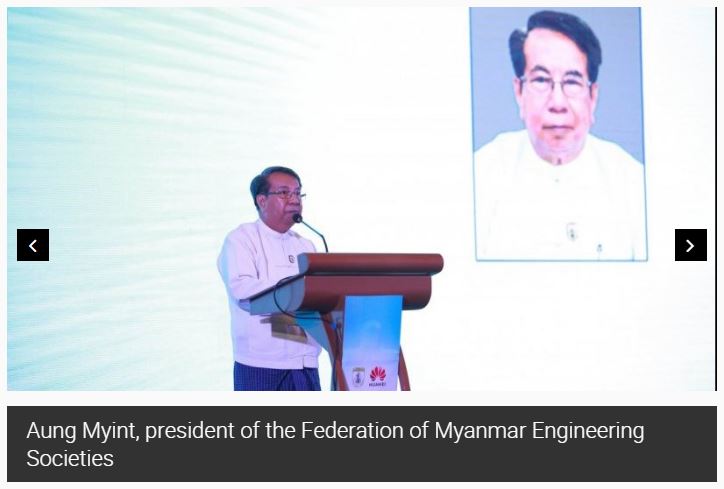Myanmar to boost indoor network coverage
WITH MORE people moving to major cities for better opportunities, Myanmar is planning to improve the quality of its indoor network coverage as part of preparing for the fifth generation of wireless technology (5G), officials say.
Soe Naing, deputy director-general of the Posts and Telecommunications Department, told the recent Myanmar Indoor Coverage Digitalisation Summit 2019 that the country would focus on improving the indoor experience of users, given that more than 70 per cent of the traffic occurs indoors, especially in urban areas.
“As Myanmar has a hot climate and a long rainy season, people usually spend their time mostly in indoor areas,” he said.
“The quality of the indoor network greatly affects the user experience. In the future 5G era, we will need more and more indoor sites, especially in highly intensive areas such as shopping malls and residential buildings.”
The official stressed the need for a reliable and stable solution to meet the requirements of users without causing trauma and destruction to buildings.
“On the one hand, we need real estate developers to reserve some space and a pipeline for communication devices in the buildings,” he said.
“On the other hand, each operator and supplier needs to provide the best solution and high-quality installation services in order not to damage buildings and the environment.”
As networks need to pay more attention to evolvability, the input of communication equipment integrators is much needed to ensure healthy and stable development of the network, he said.
According to the official, as Myanmar rapidly enters the information era, the transmission of information is inseparable from the network.
“The information transmitted by the network is becoming more and more abundant, and the amount of data transmitted is also on the rise,” he said. As the carrier of information, optical fibre plays a critical role in the transmission of information, he added.
“Nowadays, many smart terminals have entered the family unit. The rate of using smartphones now exceeds 85 per cent [of the population],” he said.
“These smart devices have greatly enriched the daily life of Myanmar people, ensuring convenience. Communicating with others anytime and anywhere greatly improves the efficiency and shortens the distance between each other.”
Win Tint, permanent secretary of the Ministry of Construction, echoed Soe Naing’s view.
“We communicate with families and friends through mobile phones, tablets and smart watches. So, the quality of indoor coverage is really important,” he said.
He urged real estate developers to reserve space for the devices and cables during the design phase in order to facilitate the subsequent installation and access of telecom devices.
“This will help avoid repeated drilling and reconstruction, improve the stability and safety of buildings, and reduce the implementation time and related costs for all parties,” he said.
Win Tint said real estate developers and property management companies should cooperate with operators, ensuring support that would improve access to smart devices.
“With the aid of new technologies, we need intelligent equipment to connect hundreds of thousands of households with the rest of the world. Today, smart terminals have become a necessity in people’s daily life,” he said.
He urged the creation of a fair environment for all parties so as to reduce communication costs and improve efficiency.
Aung Myint, president of the Federation of Myanmar Engineering Societies, said the current indoor network in Myanmar is unable to match the demand of people, especially in shopping malls, high-rise buildings, hospitals and large-scale complexes.
Anytime, anywhere
“As Myanmar people wish to enjoy high-quality network services anytime and anywhere, the indoor network becomes extremely important,” he said.
With growing urbanisation, indoor networks now carry a large number of users and heavy traffic. Aung Myint foresees more and more complexity in Yangon’s future.
In order to deploy solutions in different scenarios, every stakeholder should work together to establish a single standard, he urged.
“Each operator needs to provide the best and evolving scenario solution on par with the planning and construction standards of its own network, select high-quality suppliers to complete the integration, and establish an end-to-end service guarantee mechanism,” he said.
He stressed the need for government support to real estate development. “At the beginning of the construction, the developers will incorporate it into the overall planning of the building, reserve equipment installation space, cable and pipelines, etc, in advance,” he said.
He urged all developers to ensure each operator’s access to their properties to facilitate their networks. The suppliers must guarantee a high quality to minimise operating costs and enhance the user experience, he said.
“We hope relevant government functions will provide guidance to regulate the implementation of Myanmar’s indoor network and fibre deployment,” he said.
Aung Myint also underscored the importance of turning Yangon into an environmentally friendly smart city, which requires all parties to work together and contribute.
“Indoor coverage will play a key role in smart cities. Optical fibre will serve as the most important carrier for transmission of information,” he said.
“This will bring a high-end digital experience to thousands of households and quickly respond to people’s needs. To this end, establishing the standard is extremely important.”
Source: http://www.nationmultimedia.com/detail/Economy/30370095


 English
English




